Spider Collector's Journal (29th page: 2019) Copyright © 2019 by Rod Crawford
Here's the 29th page of narratives of fun (and not so fun) trips to collect spiders for research at the Burke Museum, some accompanied by capable field volunteers: Laurel Ramseyer and new recruits. Most also appeared in Scarabogram, newsletter of "Scarabs: The Bug Society." Dates of field trips head each paragraph. Maps showing the location of sites within Washington state follow the grid system outlined in the Washington Spider Checklist. RETURN TO INDEX
Where you see this button ![]() in a
field trip account, click it to get a page of collecting site photos!
in a
field trip account, click it to get a page of collecting site photos!
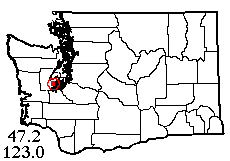 |
![]() 15 III 2019: In December and January we were far too busy moving mountains of stuff to the new museum building. In February, we had a record-breaking snowfall! So it was March before things came together for the first (and last) field trip of the winter of 2018-19. The weather finally warmed up in mid-month, so Laurel and I headed for Bayshore Preserve on Oakland Bay (near Shelton) on the 15th. The preserve is a former golf course subsequently acquired by Capitol Land Trust; it occupies part of a small peninsula in the bay, sharing same with a Department of Wildlife parcel, where we parked in becoming-warm sunshine.
15 III 2019: In December and January we were far too busy moving mountains of stuff to the new museum building. In February, we had a record-breaking snowfall! So it was March before things came together for the first (and last) field trip of the winter of 2018-19. The weather finally warmed up in mid-month, so Laurel and I headed for Bayshore Preserve on Oakland Bay (near Shelton) on the 15th. The preserve is a former golf course subsequently acquired by Capitol Land Trust; it occupies part of a small peninsula in the bay, sharing same with a Department of Wildlife parcel, where we parked in becoming-warm sunshine.
My first order of business was to beat conifer foliage, which produced 10 spider species but nothing rare. Near where I'd been beating, I spotted some nice deep leaf litter deposits, well segregated into cottonwood and maple litter. Sifting cottonwood litter produced a lot of spiders so I kept doing it; to my later chagrin, all but 1 of the many spiders were the common Microneta viaria; only one isopod species too! The nearby maple litter was a little better, increasing the litter spider species to 5; some maple litter from a large tree in a grass field made that 9 litter species, not so bad after all. I swept 6 species from the very extensive grasslands (no doubt formerly the golf-course lawns), and understory added one.
Meanwhile, Laurel did a lot of moss sifting, getting 7 species from tree trunk moss in the golf course area and 3 more from trees by a stream. On the other hand, moss on the ground added nothing at all that was mature, which is fairly typical. She also got a few under wood on the ground, and tapped 100 Douglas-fir cones which produced the day's most interesting species, an unidentified erigonine female. At this site, practically at sea level, I spotted one unmelted patch of last month's snow!
Finally we stopped in the town of Shelton where Laurel had spotted some pine cones (of the non-native Pinus nigra) on the drive in, in a tiny pocket park. Tapping 65 of these added no different species, but I added a couple from nearby buildings, for a grand total of 37. For a change, we ate at Dairy Queen..
 |
![]() 21 III 2019: Fall before last, we'd hiked in from the Gold Creek Trailhead in Green Mountain State forest, Kitsap County, to a fine wetland and other good habitats. This time (on the 2nd day of Spring), we wanted to sample the area closer to the trailhead, where we only took 3 species in passing before. It was the very last area to sample on the Kitsap peninsula! On the way, Laurel stopped for sandwiches near Gig Harbor and found some pine cones by the parking lot; adding 2 species for that area including a range extension for recently introduced Zodarion rubidum.
21 III 2019: Fall before last, we'd hiked in from the Gold Creek Trailhead in Green Mountain State forest, Kitsap County, to a fine wetland and other good habitats. This time (on the 2nd day of Spring), we wanted to sample the area closer to the trailhead, where we only took 3 species in passing before. It was the very last area to sample on the Kitsap peninsula! On the way, Laurel stopped for sandwiches near Gig Harbor and found some pine cones by the parking lot; adding 2 species for that area including a range extension for recently introduced Zodarion rubidum.
It was cool and sunny at the trailhead. We hiked a half mile or so to where the trail crosses Gold Creek and forks; here Laurel collected from the bridge (13 species!), I sifted alder litter (added 4) and beat understory (added 3 and duplicated many of the bridge spiders), and Laurel sifted moss (added 5). Though a weekday, the trailhead parking lot was crowded and there were lots of hikers on the trail. Curious ones who asked questions! Halfway back to the trailhead, at a spot where there were maple and Douglas-fir trees, I sifted (added 3) and Laurel tapped cones (added 2, including the very first Ozyptila pacifica found in a cone). One more spider from the trailhead outhouse, then we were headed north to different habitats in the Tin Mine Creek area.
Parking at a gated road, we walked up to an 8-year-old clearcut where conifer foliage added 6 species, roadside grass added 2, and a juvenile wolf spider and Cyclosa were easy to rear, making in all 40 species for the day; the prior sample from the trailhead makes it 43. The Kitsap Peninsula is all sampled now!
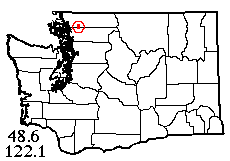 |
![]() 31 III 2019: It was the last day of March, unseasonably warm and sunny, and I had a shiny new trip plan for sites on the South Fork Nooksack River in south central Whatcom County. Laurel and I left Highway 9 on Saxon Road and stopped first at Saxon Cemetery, a seemingly old country burial-ground where most of the graves I saw were relatively new. Woodland around the fringes, non-native evergreen shrubs and slightly unkempt grass promised productive habitats. However, we found spiders here to be relatively sparse — enough, however, for a sample. First, I beat 6 species from the few accessible conifer branches I could find. Laurel added 2 good species from fir-cones and sifted 7 from tree-trunk moss. I settled down to sift 3 bags of maple litter, but the litter spiders were rather sparse here; diverse enough, however, to give me 11 species. Laurel added 3, including 2 nice females of Metellina mimetoides, from grave monuments and a storage container. We moved on from here with 26 species, including the only Ozyptila crab spider of the trip, a female O. pacifica from litter.
31 III 2019: It was the last day of March, unseasonably warm and sunny, and I had a shiny new trip plan for sites on the South Fork Nooksack River in south central Whatcom County. Laurel and I left Highway 9 on Saxon Road and stopped first at Saxon Cemetery, a seemingly old country burial-ground where most of the graves I saw were relatively new. Woodland around the fringes, non-native evergreen shrubs and slightly unkempt grass promised productive habitats. However, we found spiders here to be relatively sparse — enough, however, for a sample. First, I beat 6 species from the few accessible conifer branches I could find. Laurel added 2 good species from fir-cones and sifted 7 from tree-trunk moss. I settled down to sift 3 bags of maple litter, but the litter spiders were rather sparse here; diverse enough, however, to give me 11 species. Laurel added 3, including 2 nice females of Metellina mimetoides, from grave monuments and a storage container. We moved on from here with 26 species, including the only Ozyptila crab spider of the trip, a female O. pacifica from litter.
Our second site was Saxon Bridge, crossing the South Fork with a nice parking area and lovely habitats. Here, my first concern was to hunt for wolf spiders on the gravel bar (I'd only seen and missed 2 at the cemetery). No sooner was I on the gravel when a nice big female Pardosa lowriei started leading me a merry chase, several times scooting out into the river and back, but I finally got her. A male was much easier, and a smaller male at the edge of a sandy stretch proved to be Pardosa xerampelina, both very nice records. Meanwhile, Laurel had been trying the riverside moss but found it very uncharacteristically dry and not giving her what she wanted. We added some species from bridge guardrails and fern understory, and I sifted some more maple litter with only 2 species different from the cemetery. Still, even with rather sparse pickings we finished a fairly short day with 36 species and some good records to boot; also having seen some brand new territory.
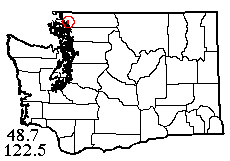 |
![]() 26 IV 2019: Finally, after most of a month of wet or iffy weather, we had a field-friendly day! I had a dozen or so trip plans, and Laurel selected the one to the Nooksack River delta. We started at Marietta Veterans Park, just over a mile up from the bay on a side channel called Silver Creek. The park was fairly dry (although it's known to flood in the spring) and had a variety of spider habitats; leaf litter alone gave 11 species so it obviously hasn't flooded this year, including another record of the introduced wolf spider Trochosa ruricola. Laurel added 3 species from sifting some sparse moss, nothing much from Douglas-fir cones, and Salticus from the playground. I swept 8 from grass and dandelions (no Misumena though) and found one solitary Pardosa vancouveri active. We were just outside the Lummi reservation but the park is decorated with native carvings (see album). 22 species so far.
26 IV 2019: Finally, after most of a month of wet or iffy weather, we had a field-friendly day! I had a dozen or so trip plans, and Laurel selected the one to the Nooksack River delta. We started at Marietta Veterans Park, just over a mile up from the bay on a side channel called Silver Creek. The park was fairly dry (although it's known to flood in the spring) and had a variety of spider habitats; leaf litter alone gave 11 species so it obviously hasn't flooded this year, including another record of the introduced wolf spider Trochosa ruricola. Laurel added 3 species from sifting some sparse moss, nothing much from Douglas-fir cones, and Salticus from the playground. I swept 8 from grass and dandelions (no Misumena though) and found one solitary Pardosa vancouveri active. We were just outside the Lummi reservation but the park is decorated with native carvings (see album). 22 species so far.
The south trailhead for the Nooksack dike top trail had different habitats, marshy meadows with lots of Pardosa metlakatla running around, and forest with a lot of Sitka spruce. Spruce foliage gave me 11 species including a very good sample (both sexes) of Dismodicus #1, a little red-legged erigonine. We both added a few from sweeping grass in different habitats. Laurel finally found some moss on willows beside a backwater channel, which added a couple of unusual microspiders. Then she finally found one Misumena on a dandelion! Toward the end, Laurel happened to spot a jumping spider peeking out of the spent seedhead of a bull thistle; a male Metaphidippus mannii! So she spent some time sampling the seedheads getting other cool spiders including the second Washington record of the ant mimic salticid Synageles venator! Tappping spruce cones gave good stuff too, including a male erigonine I can't yet identitfy. Total for the area, 43 species.
I tried also walking south along the river from our site on an unsigned, sandy dirt road; but the habitat was totally different, largely blackberry. A very curious thing seen on the main road: a Lummi Nation police car, all lights flashing but going very slowly, leading a sort of parade of 5 other assorted vehicles!
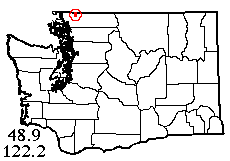 |
![]() 30 IV 2019: Laurel and I, this time with the welcome assistance of Jerry Austin, set off for the town of Sumas on the Canadian border, in between Lynden and Maple Falls where we'd collected last year. We had 3 sites picked out around the town, and hoped to find accessible forest in a range of hills to the SE. Each place contributed something.
30 IV 2019: Laurel and I, this time with the welcome assistance of Jerry Austin, set off for the town of Sumas on the Canadian border, in between Lynden and Maple Falls where we'd collected last year. We had 3 sites picked out around the town, and hoped to find accessible forest in a range of hills to the SE. Each place contributed something.
The first site, a flood control tract on Johnson Creek, was mostly overgrown with blackberry but some moss on a maple tree allowed Laurel to add a data point for the introduced crab spider Ozyptila praticola, while Jerry found a big female Trochosa under wood and we swept a few others: 7 species, 5 of them introduced. Next stop Howard Bowen Park where Laurel added 3 good species from buildings, I found a few under lumber and an old carpet, and Jerry worked hard sweeping some remnants of field grass for very few spiders, but including several good ones, an uncommon orbweaver and yet another locality for the newly introduced ant mimic jumping spider Synageles venator. Then we moved on to the Sumas Cemetery which added zero spider species, but gave Laurel a chance to tap 100 pine cones, giving more data for that project. And yet more Synageles — one year after first finding it, it's already getting common!
Investigating the forested hills, we found nothing accessible along Reese Hill Road, so we tried farther south on South Pass Road, and quickly found an overgrown, unmarked side trail that took us down to a perfectly good riparian forest habitat on Breckenridge Creek, hooray! Of course my first order of business was to find some nice-looking maple litter and sift it. Very, very few spiders to be found! But it did add 4 good species. Laurel found the moss here unexpectedly dry but it did add 6 more species. Both Jerry and I swept understory (he grass, me ferns) which yielded 8 species; then we both tapped dead wood for a total of exactly 1 identifiable specimen! Spruce cones, aerial webs, and grass by the highway each added one more species for a total of 41, a good result from a beautiful pleasant day.
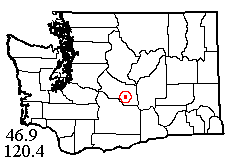 |
![]() 5 V 2019: Now it was May and we hadn't been to eastern Washington yet. So, choosing a day when west side weather might be iffy, we crossed the pass and collected around the small town of Kittitas. First and best, we worked on a strip of public land where Cooke Creek crosses the regional rail-trail at the south edge of town. I swept riparian grass near the creek for 8 species, while Laurel swept along the trail getting 4 that were different and 3 the same. Most importantly, she swept a small wolf spider (only adult wolf spider taken) that turned out to be Pardosa wasatchensis, our first specimen ever of this rarity! Also at this site, I added 4 species from willow litter; the gate, a Russian olive tree and some pine foliage added one each. Just to the south, Laurel had spotted some pine trees (a non-native species) at a sewage treatment plant; the pine cones there produced 6 species (3 new for the site including uncommon Tibellus gertschi). Finally, the new habitat discovered last week, bull thistle heads, was tried producing only 2 species, but one was the extremely rare, tiny jumping spider Talavera minuta!
5 V 2019: Now it was May and we hadn't been to eastern Washington yet. So, choosing a day when west side weather might be iffy, we crossed the pass and collected around the small town of Kittitas. First and best, we worked on a strip of public land where Cooke Creek crosses the regional rail-trail at the south edge of town. I swept riparian grass near the creek for 8 species, while Laurel swept along the trail getting 4 that were different and 3 the same. Most importantly, she swept a small wolf spider (only adult wolf spider taken) that turned out to be Pardosa wasatchensis, our first specimen ever of this rarity! Also at this site, I added 4 species from willow litter; the gate, a Russian olive tree and some pine foliage added one each. Just to the south, Laurel had spotted some pine trees (a non-native species) at a sewage treatment plant; the pine cones there produced 6 species (3 new for the site including uncommon Tibellus gertschi). Finally, the new habitat discovered last week, bull thistle heads, was tried producing only 2 species, but one was the extremely rare, tiny jumping spider Talavera minuta!
Our second site in Kittitas looked very nice from the air, Palmiero Park, but it turned out to be mostly mowed grass and the wooded part was extremely narrow. Still, I added 2 species from cottonwood litter and Laurel, 2 more from pine foliage. In all, 27 species at Kittitas, making 29 with two prior house spider records.
We had a couple hours left, and I wanted to get a start on sampling the area directly south: Badger Pocket, a place I'd seen on maps for decades but never visited. It's a valley of farmland within a loop of irrigation canal, with forbidden Army land on the other side, and nothing public but the county road rights-of-way; a nice challenge to get a sample! We started at the south, most distant edge of the valley on Silica Road, where we found a nice roadside stand of sagebrush to beat. The spot was extraordinarily peaceful, with no traffic to speak of and just a gentle breeze. The sagebrush got me only 3 species (others were present, but juvenile) while Laurel added 7 more from sweeping along the non-Army side of the canal. I found nothing under the few rocks, and a second sweep site a half mile north added nothing new. But on our way out, we stopped at a roadside row of planted Ponderosa pines where tapping the cones added 4 more species and I added one additional Dictyna from plant-head webs. Fifteen, a nice start for the area, and a lovely, not-too-hot day to do it in. We barely made it to Mountain High Hamburgers before it closed.
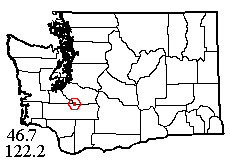 |
![]() 12 V 2019: For a change, we went south this week on a relatively short trip to a "hole" in my collection coverage in rural Pierce County. The primary site was Alder Cemetery, on a sort of peninsula in the middle of large Alder Reservoir on the Nisqually River. Pleasantly remote but easily reached, the site is on a one-lane rural road that had perhaps 2 vehicles per hour. You couldn't exactly call it peaceful, because the farm right across the road rejoiced in a gaggle of peafowl that were relentlessly noisy! But apart from the avian cries, all we heard was occasional motorboats. While Laurel hunted some cones to tap, I beat 10 species from conifer foliage, quite a nice start. In contrast, Laurel found few spiders and only one additional species on 100 Douglas-fir cones. On the lake shore, reached through a fringe of woods beyond the cemetery fence, I found several accumulations of driftwood that had enough spiders under it to keep me looking for some time, though in the end only two species added to the list. Laurel was now sifting moss which, though rather sparse, added 7 species, while the leaf litter I found behind shaded drift logs above the lake added 8. By this time the tall grass (some along the road, some along the lake and some — with stealth nettles — at the cemetery edge) was dry enough to sweep, adding 6 species; understory added 3 more. Laurel and I found 4 varied species active on the ground, including uncommon, attractive gnaphosid Callilepis pluto. Tombstones and flowering shrubs added nothing new, but Laurel found the 40th species under a rock by the lake.
12 V 2019: For a change, we went south this week on a relatively short trip to a "hole" in my collection coverage in rural Pierce County. The primary site was Alder Cemetery, on a sort of peninsula in the middle of large Alder Reservoir on the Nisqually River. Pleasantly remote but easily reached, the site is on a one-lane rural road that had perhaps 2 vehicles per hour. You couldn't exactly call it peaceful, because the farm right across the road rejoiced in a gaggle of peafowl that were relentlessly noisy! But apart from the avian cries, all we heard was occasional motorboats. While Laurel hunted some cones to tap, I beat 10 species from conifer foliage, quite a nice start. In contrast, Laurel found few spiders and only one additional species on 100 Douglas-fir cones. On the lake shore, reached through a fringe of woods beyond the cemetery fence, I found several accumulations of driftwood that had enough spiders under it to keep me looking for some time, though in the end only two species added to the list. Laurel was now sifting moss which, though rather sparse, added 7 species, while the leaf litter I found behind shaded drift logs above the lake added 8. By this time the tall grass (some along the road, some along the lake and some — with stealth nettles — at the cemetery edge) was dry enough to sweep, adding 6 species; understory added 3 more. Laurel and I found 4 varied species active on the ground, including uncommon, attractive gnaphosid Callilepis pluto. Tombstones and flowering shrubs added nothing new, but Laurel found the 40th species under a rock by the lake.
On our way back to the highway, we stopped by a more lush-looking riparian forest on Lillie Dale Road. Here, further moss-sifting added 5 more species, while I found abundant Tibellus and Pardosa metlakatla in an adjacent small meadow, making 47 for the area, a splendid sample! On the way in, Laurel's sharp eyes had noted a fine accumulation of pine cones in front of an apartment building in Eatonville, which we stopped to sample on our way home. This completely made up for the poor earlier fir-cone sample; 100 cones had 8 identifiable species, including some unusual records and adding 7 to the 26 species previously known from that gridspace. A good day!
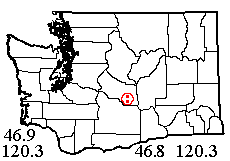 |
![]() 18 V 2019: Around 3 miles east of Kittitas, where we collected on May 5, the old time railroad men dubbed a siding "East Kittitas" hoping it would become another successful town. Now the railroad itself is gone, turned to a trail, and at East Kittitas (besides the trailhead) is one house and a hay barn grandiosely called a trading post. But it made a fine spider locality! Right off, Laurel and I swept 8 species from adjacent grassy fields including a mature Thanatus and a good set of Metepeira foxi. I then beat 5 additional species from sagebrush while Laurel added 6 more from the walls of the hay barn (excuse me, trading post), including another female of the rare wolf spider Pardosa wasatchensis she'd taken at Kittitas. Next, we hiked a half mile up the trail (shared by a friendly couple with horses and dogs) to a rock cut where we could access an old shale quarry. Here we got 5 species under rocks (Laurel catching the prize, Phrurotimpus parallelus) and another orbweaver, Metellina mimetoides. 25 species already!
18 V 2019: Around 3 miles east of Kittitas, where we collected on May 5, the old time railroad men dubbed a siding "East Kittitas" hoping it would become another successful town. Now the railroad itself is gone, turned to a trail, and at East Kittitas (besides the trailhead) is one house and a hay barn grandiosely called a trading post. But it made a fine spider locality! Right off, Laurel and I swept 8 species from adjacent grassy fields including a mature Thanatus and a good set of Metepeira foxi. I then beat 5 additional species from sagebrush while Laurel added 6 more from the walls of the hay barn (excuse me, trading post), including another female of the rare wolf spider Pardosa wasatchensis she'd taken at Kittitas. Next, we hiked a half mile up the trail (shared by a friendly couple with horses and dogs) to a rock cut where we could access an old shale quarry. Here we got 5 species under rocks (Laurel catching the prize, Phrurotimpus parallelus) and another orbweaver, Metellina mimetoides. 25 species already!
Next stop was a roadside irrigation canal where there were some pine trees, but alas, the cones if any were inaccessible. However, I swept 3 more species beside the water. To finish off the East Kittitas sample, we crossed the freeway to Boylston Road where my hopes of an accessible willow grove were fulfilled. Sifting the litter added 4 good species, while Laurel added some others from the bridge over Parke Creek and a little more sweeping. Zero to 35 species in 2/3 of one field day!
Our last goal was to supplement the earlier partial sample from Badger Pocket to the south. I'd selected 3 roadside sites that I hoped would have different habitats. First site, at Nicolai Road, gave us plenty to sweep where a canal runs along the road with no man's land in between. While several horses studied us with keen interest, we swept 11 species of which 4 were new to Badger Pocket. Next stop, along Morrison Road, gave us a nice triangle of unclaimed land between a county road and a canal, containing a big pile of concrete rubble and an elm tree with litter under it! The under-concrete fauna added nothing new, but Laurel found a Dictyna terranea between 2 plastic flowerpots there. Sifting elm litter added 2 species while Laurel got one orbweaver on the canal bridge, one wolf spider under a rock, plus Linyphantes aeronauticus and one unknown male by sweeping. The third pre-selected site didn't pan out. On the way out, we stopped off at Laurel's pine cone site (WPA Road) from last time, where I beat pine foliage adding the pale jumping spider Phanias watonus. 27 species from nothing but county-road roadsides! Insert imaginary cartoon of us patting ourselves on the back.
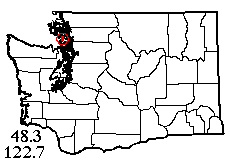 |
![]() 24 V 2019: Trying to coordinate 4 people and a vascillating weather forecast for a field trip is something I wouldn't want to try every week. But on the Friday before Memorial Day weekend, 3 of us (me, Jerry Austin and Della Scott) headed north for a site predicted to be "partly sunny," Swantown Lake on the NW coast of Whidbey Island. It was raining in Seattle and Everett and Arlington — but dry by Mount Vernon. However, after we crossed the Deception Pass Bridge things looked dismally wet. Almost there, we soldiered on, and arriving at our destination things still looked iffy but at least not soaked. We had lunch in a picnic shelter at nearby Joseph Whidbey State Park, then I set out to collect from the vast marsh and meadow on the north side of Swantown Lake county habitat preserve. I had hoped for some marshland rarities here, but the best-laid plans… The road-edge vine thickets prevented access at most points, and at the few places I could get through that, cattail stands were too dense to penetrate and too stiff to sweep! But I got a sweep sample anyway by sweeping beside the road and in a small but accessible field at the north end, getting at least 7 species plus a Pardosa moesta active in the field. Sifting grass/leaf litter under a large shrub that shaded out the vines added 3, plus a juvenile Ozyptila crab spider. Across the road, I searched in vain for Salticus on the beach house fences, but found some pine cones and tapped 15, adding 2 species, one of them uncommon Erigone cristatopalpus. Meanwhile, Jerry was doing miserably and added only one species, a Zelotes fratris under driftwood. The last specimen from this site was a male Ozyptila praticola, far out of range, in short-term pitfalls (Laurel says "Noooo!").
24 V 2019: Trying to coordinate 4 people and a vascillating weather forecast for a field trip is something I wouldn't want to try every week. But on the Friday before Memorial Day weekend, 3 of us (me, Jerry Austin and Della Scott) headed north for a site predicted to be "partly sunny," Swantown Lake on the NW coast of Whidbey Island. It was raining in Seattle and Everett and Arlington — but dry by Mount Vernon. However, after we crossed the Deception Pass Bridge things looked dismally wet. Almost there, we soldiered on, and arriving at our destination things still looked iffy but at least not soaked. We had lunch in a picnic shelter at nearby Joseph Whidbey State Park, then I set out to collect from the vast marsh and meadow on the north side of Swantown Lake county habitat preserve. I had hoped for some marshland rarities here, but the best-laid plans… The road-edge vine thickets prevented access at most points, and at the few places I could get through that, cattail stands were too dense to penetrate and too stiff to sweep! But I got a sweep sample anyway by sweeping beside the road and in a small but accessible field at the north end, getting at least 7 species plus a Pardosa moesta active in the field. Sifting grass/leaf litter under a large shrub that shaded out the vines added 3, plus a juvenile Ozyptila crab spider. Across the road, I searched in vain for Salticus on the beach house fences, but found some pine cones and tapped 15, adding 2 species, one of them uncommon Erigone cristatopalpus. Meanwhile, Jerry was doing miserably and added only one species, a Zelotes fratris under driftwood. The last specimen from this site was a male Ozyptila praticola, far out of range, in short-term pitfalls (Laurel says "Noooo!").
Our second site was the edge of a Douglas-fir stand along the Crosby Road right-of-way. I beat 15 species from the fir foliage! Some of them duplicated the sweep sample, but it still added quite a few, including uncommon Theridion agrifoliae. Jerry got one more sweeping the roadside. Finally we stopped at a further bend in Crosby Road where I gathered in a couple of bags of alder litter within the right-of-way, sifting it with Della's help and adding 6 more species including uncommon Blabomma californicum. Total, 33 species including some fine records, and the last unsampled area on Whidbey Island taken care of!
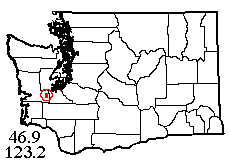 |
![]() 30 V 2019: Having persuaded Laurel to take another trip southward, we headed for Grays Harbor County west of Olympia, where I had a promising trip plan on private timberland west of McCleary, and a backup plan farther south near Porter. We started following my printed directions from McCleary and quickly got confused. A couple of helpful chaps in a lumberyard we turned into by accident, confused me even further. It turns out my printout had omitted 2-3 important steps! In driving around the area, we went right by the road to our site but with no sign, it went unrecognized. Giving up for that day, we headed south to Plan B.
30 V 2019: Having persuaded Laurel to take another trip southward, we headed for Grays Harbor County west of Olympia, where I had a promising trip plan on private timberland west of McCleary, and a backup plan farther south near Porter. We started following my printed directions from McCleary and quickly got confused. A couple of helpful chaps in a lumberyard we turned into by accident, confused me even further. It turns out my printout had omitted 2-3 important steps! In driving around the area, we went right by the road to our site but with no sign, it went unrecognized. Giving up for that day, we headed south to Plan B.
The meadows on Porter Creek were very easy to find, but not as extensive as they looked from the air. Large areas, it turns out, were either overgrown with blackberry or low, young alder trees. However, one fair-sized grassy tract was readily accessible; sweeping that plus the grassy roadsides yielded at least 9 species, and Pardosa vancouveri were still active though elusive. Laurel sifted a few loads of moss from adjacent maple stands, but it wasn't as productive as she thought, producing only 3 mature species that I hadn't already swept. The spiders in maple litter were sparse but good and added 5, including a Bathyphantes I don't recognize. The fern understory at the site was very productive; both of us sampled different areas and added 9 more species, including the native Ozyptila pacifica (mine) and a nice male Trogloneta (Laurel's). I found Laurel some Douglas-fir cones, but they produced very little. Still, we already had 29 species.
Just up the hill at the edge of a clearcut, I beat hemlock foliage adding 2 species, and found others in aerial webs and on salal, including a male Philodromus of unclear identity. Laurel swept 4 more we hadn't got at the meadow and found a second Pardosa species running about. Despite time wasted looking for the elusive first site, we had 36 species from the Porter Creek area. On the way home, we stopped at a pine cone deposit Laurel had spotted in McCleary in front of the Simpson Door Co. (non-native black pines), where 55 cones added 3 species to the catch from a 2007 trip in that area.
 |
![]() 2 VI 2019: With Laurel under the weather, I wanted to initiate a potential new field volunteer, UW student Kiara Milcoff, who proved very interested and very "game" even though she's had little prior experience in remote field locations. Kiara's schedule required a somewhat late start but I figured, it's June, the days are long! Giving her a choice of several possible destinations, she decided on venturing into the mountains, up the Middle Fork Snoqualmie River beyond the area sampled with Laurel last fall. We reached the right road without a hitch, but no sooner had we crossed the Taylor River bridge but the road got much rougher. After maybe a mile of rough rocky road, Kiara understandably didn't want to subject her Prius to more, so we got out and walked. Just about 2.5 miles later (and past some even more dreadful sections of road), we were in the area I wanted to sample, but unable to cruise around, we had to content ourselves with a limited selection of habitats. Still, the habitats we could reach were OK!
2 VI 2019: With Laurel under the weather, I wanted to initiate a potential new field volunteer, UW student Kiara Milcoff, who proved very interested and very "game" even though she's had little prior experience in remote field locations. Kiara's schedule required a somewhat late start but I figured, it's June, the days are long! Giving her a choice of several possible destinations, she decided on venturing into the mountains, up the Middle Fork Snoqualmie River beyond the area sampled with Laurel last fall. We reached the right road without a hitch, but no sooner had we crossed the Taylor River bridge but the road got much rougher. After maybe a mile of rough rocky road, Kiara understandably didn't want to subject her Prius to more, so we got out and walked. Just about 2.5 miles later (and past some even more dreadful sections of road), we were in the area I wanted to sample, but unable to cruise around, we had to content ourselves with a limited selection of habitats. Still, the habitats we could reach were OK!
A quick sweep of roadside verge got me 6 species, a good start! Next we spent some time beating fern-salmonberry understory, bringing us up to 12 species. Kiara spotted one wolf spider in the road but missed it (a common experience), but did get a male microspider Zygottus corvallis she found active on roadside mud. After sifting a couple bags of tree trunk moss, we were already up to 18 species.
All this time (and throughout the day) there was an intermittent stream of vehicles, mostly jeeps and trucks, jouncing back and forth on this remote, bad road to a destination we couldn't really fathom. Only one stopped and asked what we were doing: "Spiders? Freaky!" But on the plus side, the salmonberries were getting ripe. Kiara had never before eaten a wild berry or fruit — I converted her in a big way! Anyway, as the day wore on I hungered for a good leaf litter sample (to sift, not eat), and to get that, we backtracked to a pure stand of bigleaf maple. Here we sifted 2 bags of good litter that added 7 more species; one more bag of somewhat different moss added 2 more. End result, 27 species from the place we had to walk to, and really from only 4 habitats that we could reach. Can't complain!
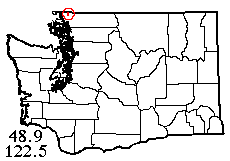 |
![]() 9 VI 2019: After a predicted wet week (that in reality wasn't very wet), Laurel was back in action and wanted to fill in a hole in her crab spider study up near the Canadian border, between the towns of Lynden and Blaine. There wasn't much terrain accessible to collectors there, but I cobbled together a three-site trip plan that hit all the necessary habitats. Our first stop was a public water access site on the Nooksack River at Harksell Road. As we feared, the site (a narrow strip between the river and farm fields) was heavily invaded by blackberry, but unexpectedly also had a major stand of invasive giant knotweed! However, disturbed field habitat to sweep was not in short supply and I began by sweeping it. Instead of the usual Tetragnatha, Tibellus, etc., I mainly got a lot of microspiders. I couldn't tell at the time if most of them were mature, but I got lucky in that respect: my sweeping yielded 9 species, including three of our local Erigone species! Wolf spiders were in very short supply, but after one got away I managed to catch a very nice Pardosa xerampelina. Laurel found very little moss to sift, but it still added 4 species, plus one measly juvenile Ozyptila (what she came for). I sifted litter while Laurel beat blackberry and we came away from this unpromising site with a nice start of 19 species.
9 VI 2019: After a predicted wet week (that in reality wasn't very wet), Laurel was back in action and wanted to fill in a hole in her crab spider study up near the Canadian border, between the towns of Lynden and Blaine. There wasn't much terrain accessible to collectors there, but I cobbled together a three-site trip plan that hit all the necessary habitats. Our first stop was a public water access site on the Nooksack River at Harksell Road. As we feared, the site (a narrow strip between the river and farm fields) was heavily invaded by blackberry, but unexpectedly also had a major stand of invasive giant knotweed! However, disturbed field habitat to sweep was not in short supply and I began by sweeping it. Instead of the usual Tetragnatha, Tibellus, etc., I mainly got a lot of microspiders. I couldn't tell at the time if most of them were mature, but I got lucky in that respect: my sweeping yielded 9 species, including three of our local Erigone species! Wolf spiders were in very short supply, but after one got away I managed to catch a very nice Pardosa xerampelina. Laurel found very little moss to sift, but it still added 4 species, plus one measly juvenile Ozyptila (what she came for). I sifted litter while Laurel beat blackberry and we came away from this unpromising site with a nice start of 19 species.
Next stop, a road crossing of Bertrand Creek that had some woodland along one side of the road, also some nice riparian marsh grass along the creek. Here, Laurel hoped to find better Ozyptila in the tree trunk moss. Instead, she got none! But her sifting did add another 4 species. I had hopes for the understory but found its spiders to be mainly those ubiquitous invasives, Enoplognatha ovata and Philodromus dispar. The best spiders here were 3 adult male Tetragnatha elongata swept along the creek. We got a few from the bridge and road railings, and maple litter was fairly productive. After this site we had a solid sample of 33 species.
The third pre-selected site was just below the international border on H Street Road, where I'd found some conifer foliage habitat on Street View. This added 4 species, and a large grassy field gave us some more conventional field fauna, plus the ever-reliable record of Theridion simile from Scots broom. Here we took Erigone aletris, 4th species in that genus for the day, making an excellent sample of 41 in all. And this time the Border Patrol didn't stop us.
 |
![]() 15 VI 2019: Ready to start collecting in the hills, Laurel and I headed for the Grider Lakes trailhead, a long drive on decent back roads from Sultan, to road's end just south of Spada Reservoir, the main drinking water source for Snohomish County. The forest in this area is all second growth, but very beautiful at this verdant season. We hiked eastward on the trail, not climbing much in this first half but not exactly level as it descended into gully after gully after gully, where culverts had been dug up in converting an old logging road to trail. Some of the gullies were dry but others carried water to the reservoir, destined for the faucets of Everett. The final gully to cross was Bear Creek, with no bridge across the route's biggest creek but rocks to hop across on (something I'm not too good at). But we made it to our destination, the Bear Creek recreation site on a rocky knob overlooking the reservoir, miles of water in both directions with no sign of a boat or a building.
15 VI 2019: Ready to start collecting in the hills, Laurel and I headed for the Grider Lakes trailhead, a long drive on decent back roads from Sultan, to road's end just south of Spada Reservoir, the main drinking water source for Snohomish County. The forest in this area is all second growth, but very beautiful at this verdant season. We hiked eastward on the trail, not climbing much in this first half but not exactly level as it descended into gully after gully after gully, where culverts had been dug up in converting an old logging road to trail. Some of the gullies were dry but others carried water to the reservoir, destined for the faucets of Everett. The final gully to cross was Bear Creek, with no bridge across the route's biggest creek but rocks to hop across on (something I'm not too good at). But we made it to our destination, the Bear Creek recreation site on a rocky knob overlooking the reservoir, miles of water in both directions with no sign of a boat or a building.
The rocky habitat made for open glades with flowers (not all native, alas), grass and small trees, just right for vegetation sampling. No invasive blackberry (hooray), but both salmonberries and huckleberries were yummy. My sweep sample got me only 3 adult species, but conifers had 7 more including microspiders. All native except the ubiquitous invasive Enoplognatha ovata. Each of us found one male of the uncommon "Popeye spider" Habronattus oregonensis, best species of the day. Laurel also found a male and female Phidippus johnsonii, the female with orbweaver prey. She didn't get much from Douglas-fir cones; salal and other shrubs added only one. But I found some good understory foliage that added 4, Laurel added 3 from moss-sifting, and I got 2 more from dead wood. We now had 26 species.
At this point we decided to descend into an alder-filled ravine and make our way to the invitingly grassy lakeshore. Maybe we would have better stayed near the trail! The ravine bottom was so choked with salmonberry and small logs it was like a Jungle-gym for dwarves. Drift logs formed another barrier before we could walk free beside the lake. Finally we were able to sweep that lovely grass, getting spiders that looked great at first glance, but added not one species to what we'd taken near the trail! Laurel did find one nice Pirata piraticus wolf spider on a water-edge twig. Next, back to the riparian alder forest to sift. All that moss on the trunks — giving Laurel only 2 more species! All that litter on the ground and banked behind logs — giving me only 1 more species! Then, it was my bright idea to take a short cut to the trail up the steep ravine side. Oh well, at least it wasn't much worse than the trip down. Panting, we staggered back along the up-and-down trail to the car with 31 species. Anyway, it was worth it just to spend the day in such delightful surroundings.
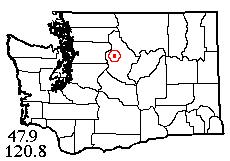 |
![]() 21 VI 2019: The weather forecast for the first day of summer vascillated good and bad for days, but a final check that morning was favorable for our preferred destination, the Napeequa River area (a second order tributary of Lake Wenatchee). Gloomy clouds shaded our journey over Stevens Pass, but began clearing up just as we entered the Wenatchee River drainage. We soon arrived at Napeequa Crossing campground (just a few sites in a strip between the road and White River), and parked at the trailhead across the road. The camp outhouses gave us 2 mature species, a good start. The trail goes along a slope above the Napeequa River and its tributary Twin Lakes Creek before ascending steeply to Twin Lakes, high on Chiwawa Ridge. Our goal was not the lakes, but a marsh near where the creek joins the river. But first we stopped at the junction of a side trail to a lookout rock, where we each noted one of our favorite habitats: Ponderosa pine cones for Laurel (they provided her with 5 good species) and a pile of fallen bark from a snag for me — not quite as productive but it got me the best species of the day, rare Theridion berkeleyi. Moving on, we soon noticed that mosquitoes would probably be annoying here. But some fellow hikers we chatted with told us this was mild compared with the clouds of them usually found on this trail!
21 VI 2019: The weather forecast for the first day of summer vascillated good and bad for days, but a final check that morning was favorable for our preferred destination, the Napeequa River area (a second order tributary of Lake Wenatchee). Gloomy clouds shaded our journey over Stevens Pass, but began clearing up just as we entered the Wenatchee River drainage. We soon arrived at Napeequa Crossing campground (just a few sites in a strip between the road and White River), and parked at the trailhead across the road. The camp outhouses gave us 2 mature species, a good start. The trail goes along a slope above the Napeequa River and its tributary Twin Lakes Creek before ascending steeply to Twin Lakes, high on Chiwawa Ridge. Our goal was not the lakes, but a marsh near where the creek joins the river. But first we stopped at the junction of a side trail to a lookout rock, where we each noted one of our favorite habitats: Ponderosa pine cones for Laurel (they provided her with 5 good species) and a pile of fallen bark from a snag for me — not quite as productive but it got me the best species of the day, rare Theridion berkeleyi. Moving on, we soon noticed that mosquitoes would probably be annoying here. But some fellow hikers we chatted with told us this was mild compared with the clouds of them usually found on this trail!
Anyway, we duly arrived at the marsh. I'd hoped there would be sweepable meadows there, but no such luck! The only grass was in standing water, and after struggling down a log-strewn slope you could only sweep what you could reach from the shore. However, at the upper end there was an area of "shrub meadow" that Laurel was able to sample from the trail, getting 10 species including an unexpected adult female of the large funnel weaver Novalena intermedia. I found some spider-rich conifer foliage, and we left the marsh (which, oddly enough, had a lot fewer mosquitoes than the forest nearby) already with a minimum sample of 21 species. A Cyclosa web spotted along the trail added one more.
Back by the road, I strolled up to where it crosses the Napeequa (just before the latter joins the White River, which flows into Lake Wenatchee, source of the Wenatchee River) in hopes of sifting cottonwood litter. The litter was pretty dry, and 2 bags of it gave me only a few spiders, only one (a Hahnia) mature; and no moss here for Laurel! But I swept several from small roadside fields, while Laurel got more off the bridge, so we ended the day with 28 species, making 29 with a prior record from the other side of the ridge. Well worthwhile, and some pleasing scenery too.
 |
![]() 30 VI 2019: Bad news, good news! The bad: the lowlands would be rather hot and my planned foothill destinations all had thunderstorms predicted! The good news, Markku Savela was back in town and as usual had rented a large SUV. Armed with this, we were able to ascend the notoriously rough road to Colockum Pass in northeastern Kittitas County. And was it ever rough! The vehicle cleared everything OK, but bounced vigorously going over the rocks. It's enough to put you off Rocky Road ice cream for life! But we did arrive at the planned site, a couple miles short of the pass at 4900 feet elevation. The season here was well advanced, there were cattle in the subalpine forest and the meadows were heavily overgrazed. But Laurel and I still managed to sweep 10 spider species, including a female Habronattus americanus for me, two Erigone spp. and a male Metepeira for her.
30 VI 2019: Bad news, good news! The bad: the lowlands would be rather hot and my planned foothill destinations all had thunderstorms predicted! The good news, Markku Savela was back in town and as usual had rented a large SUV. Armed with this, we were able to ascend the notoriously rough road to Colockum Pass in northeastern Kittitas County. And was it ever rough! The vehicle cleared everything OK, but bounced vigorously going over the rocks. It's enough to put you off Rocky Road ice cream for life! But we did arrive at the planned site, a couple miles short of the pass at 4900 feet elevation. The season here was well advanced, there were cattle in the subalpine forest and the meadows were heavily overgrazed. But Laurel and I still managed to sweep 10 spider species, including a female Habronattus americanus for me, two Erigone spp. and a male Metepeira for her.
Beating/sweeping Veratrum added nothing new, just more Theridion neomexicanum. Then that 20% chance of "showers and thunderstorms" caught up with us! There were 2 or 3 comfortably distant thunderclaps on either side, and about 3 brief periods of sprinkle not amounting to much of a wetting, then the sun came out again and allowed us to pick up where we left off! I spent a good bit of the afternoon beating conifers (pines, larches and true firs), getting a lot of cool looking spiders but, as it turned out, almost none mature; all that added only 3 species. Laurel beat Ribes bushes but got nothing new. Fortunately, she had tapped 150 of the abundant Ponderosa pine cones, adding 3 species. In the latter part of the day, we both worked on the dead wood and fallen bark habitat, which for me added a nice Callilepis, 2 uncommon Lepthyphantes, and a huge Callobius nevadensis; for Laurel, a female Micaria ant mimic of a species I don't recognize. Only 22 species (just adequate) but including several great records. Markku managed to photograph several butterfly species amid the intermittent clouds, as well as a number of plants. No doubt pickings would have been better if the site were less cow-chomped!
The drive home was made tedious by 2 separate lengthy slowdowns on I-90, but we got there. I hate to think what it would have been like on 2-lane Stevens Pass this Sunday night!
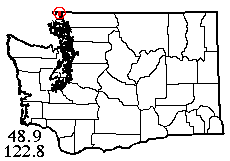 |
![]() 6 VII 2019: The three of us (Laurel, Markku and me) headed north in Markku's vehicle to an area where an SUV wasn't really needed, Birch Point SW of Blaine in far western Whatcom County. The end mile of the peninsula is in a grid-area that otherwise is all water; nothing's west of that but Point Roberts and Canada! We stopped first at a gated road where I hoped we could access some apparent timber company land. Access was no problem, and what greeted our eyes was a surprisingly beautiful landscape, a vast grassland with savanna-like open tree groups (Douglas-fir, alder, occasional maple and cottonwood); very little blackberry considering how dominant we were afraid it might be. Non-native species dominated what we got (Markku even found the dominant butterfly to be the introduced skipperling) but it was still a good catch. It was late-season for sweeping but Laurel and I between us got 8 species, including (for a change) both of the invasive Enoplognatha species mature at the same time. Beating snowberry added 5-6 species including the second Washington record of newly introduced Linyphia triangularis. Very young Douglas-firs added a species, and low-hanging cedar branches added 2 more. The groups of tall Douglas-firs in the grassland had dropped cones, but 100 of them gave Laurel only 3 specimens. But good ones, including uncommon ground spider Drassyllus depressus. She got 2 more species from plant-heads, and sifting little patches of leaf litter under trees isolated in the grass, added 2-3 more; making 22 species from this first site.
6 VII 2019: The three of us (Laurel, Markku and me) headed north in Markku's vehicle to an area where an SUV wasn't really needed, Birch Point SW of Blaine in far western Whatcom County. The end mile of the peninsula is in a grid-area that otherwise is all water; nothing's west of that but Point Roberts and Canada! We stopped first at a gated road where I hoped we could access some apparent timber company land. Access was no problem, and what greeted our eyes was a surprisingly beautiful landscape, a vast grassland with savanna-like open tree groups (Douglas-fir, alder, occasional maple and cottonwood); very little blackberry considering how dominant we were afraid it might be. Non-native species dominated what we got (Markku even found the dominant butterfly to be the introduced skipperling) but it was still a good catch. It was late-season for sweeping but Laurel and I between us got 8 species, including (for a change) both of the invasive Enoplognatha species mature at the same time. Beating snowberry added 5-6 species including the second Washington record of newly introduced Linyphia triangularis. Very young Douglas-firs added a species, and low-hanging cedar branches added 2 more. The groups of tall Douglas-firs in the grassland had dropped cones, but 100 of them gave Laurel only 3 specimens. But good ones, including uncommon ground spider Drassyllus depressus. She got 2 more species from plant-heads, and sifting little patches of leaf litter under trees isolated in the grass, added 2-3 more; making 22 species from this first site.
At our second site, we ended up collecting in closed canopy forest along the driveway to someone's private cabin, who fortunately wasn't home. Conifer foliage added 3 species; fern understory and moss-sifting, 5 species apiece. One load of maple litter added nothing, and I decided to give up on that. Laurel's fallen-bark sampling got her nothing that wasn't in the moss or understory. But we now had 37-38 species (although, 10 of them non-native) from a lowland sample in July, very satisfactory.
We also stopped at a smaller roadside grass field that had nothing different, and at the one tract of known public land in the area, a small state parcel including a public beach - but absolutely no way to approach the beach from the land side. We can't help but wonder what's going to happen to that amazing grassland. The site was clearcut around 2000, and now it's all grass; an adjacent tract, which we didn't visit, was cut around 2013. What's in its future? Surely not a golf course; there are already 2 of those on the peninsula. Probably just more ticky-tacky housing, but we hope not for a long time!
 |
![]() 12 VII 2019: With both Markku and Jerry temporarily out of town, it was just Laurel and me who went to a quite nice site on the north slope of ominously named Mosquito Ridge, at the south end of the Entiat Mountains NE of Leavenworth. The gravel roads were super-smooth and the air was mild. At our roadside site (4100' elevation), Laurel found endless Ponderosa pine cones, but got only one spider from 50 of them! I did a little better sweeping roadside foliage, 6 species. I spent a couple hours beating conifer foliage for a considerably better 11 species, to which Laurel added 3.
12 VII 2019: With both Markku and Jerry temporarily out of town, it was just Laurel and me who went to a quite nice site on the north slope of ominously named Mosquito Ridge, at the south end of the Entiat Mountains NE of Leavenworth. The gravel roads were super-smooth and the air was mild. At our roadside site (4100' elevation), Laurel found endless Ponderosa pine cones, but got only one spider from 50 of them! I did a little better sweeping roadside foliage, 6 species. I spent a couple hours beating conifer foliage for a considerably better 11 species, to which Laurel added 3.
Meanwhile, Laurel had sifted ground moss in seeps, which yielded several Sisicottus nesides, a couple other sheetweb weavers and one different Sisicottus that I suspect is the rare S. crossoclavis. Being soured on pine cones, she tried beating Douglas-fir cones, which had quite a few more spiders, though only one mature. I ended the day sifting 2 different kinds of leaf litter (willow and cottonwood-alder) from the wet seepy hillside, for an excellent total of 9 good species including an apparent new Blabomma. Laurel tried fallen pieces of bark for 3 more. By the time we headed for home we had 34 species; and traffic was light, not always the case on Stevens Pass. A productive, if unadventurous day. And no mosquitos noted!
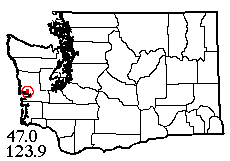 |
![]() 21 VII 2019: Again, it was just the two of us on our annual late-July pilgrimage to Grays Harbor. Wanting to sample an area due north of Hoquiam, I picked Green Banks Park on the shore of the West Fork Hoquiam River, which had been renovated (the park, not the river) by an Eagle Scout in 2014. It's still in decent condition now but could use some litter cleanup; blackberry is present but mainly by the highway. We arrived to find some kayakers entering the river (now at low tide) and two of my fellow geezers fishing from the picnic table. I swept the field habitat (fortunately the park is lawn-free) for 6 species. Taking a break from moss-sifting, Laurel tapped 50 Sitka spruce cones and got just one spider (a worthwhile one though, a male Neon). Sifting moss on spruce trunks got her 7 species and I sifted 5 from alder litter. Fern and salal understory added several; Laurel got some of the best species of the site from riverbank spruce foliage (using a special glove to whack the prickly branches). While I finished sifting, Laurel collected from some dead wood in a spruce stand and got a male of one of the rare Cybaeus species! In all, we got 31 species from the park proper and 2 more from a more natural site a short walk north along the busy highway.
21 VII 2019: Again, it was just the two of us on our annual late-July pilgrimage to Grays Harbor. Wanting to sample an area due north of Hoquiam, I picked Green Banks Park on the shore of the West Fork Hoquiam River, which had been renovated (the park, not the river) by an Eagle Scout in 2014. It's still in decent condition now but could use some litter cleanup; blackberry is present but mainly by the highway. We arrived to find some kayakers entering the river (now at low tide) and two of my fellow geezers fishing from the picnic table. I swept the field habitat (fortunately the park is lawn-free) for 6 species. Taking a break from moss-sifting, Laurel tapped 50 Sitka spruce cones and got just one spider (a worthwhile one though, a male Neon). Sifting moss on spruce trunks got her 7 species and I sifted 5 from alder litter. Fern and salal understory added several; Laurel got some of the best species of the site from riverbank spruce foliage (using a special glove to whack the prickly branches). While I finished sifting, Laurel collected from some dead wood in a spruce stand and got a male of one of the rare Cybaeus species! In all, we got 31 species from the park proper and 2 more from a more natural site a short walk north along the busy highway.
Leaving the park, we made a brief stop farther north where the highway crosses the river, now full with high tide. Here, we each added one more species. Then we headed for an upland clearcut site along Ocean Beach Road, harvested maybe 15 years ago and with plenty of young Douglas-fir and western hemlock to beat, but access to them limited by blackberry and dense shrubs. However, I managed to beat enough to add 3 more species, and both of us, by sweeping grassy verge, added 4 more. Heading for home, we had 42 species, excellent for midsummer in rather degraded habitats.
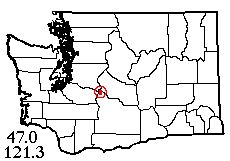 |
![]() 27 VII 2019: With Laurel out of town but Jerry back, it was Crawford and Austin as collectors, with Markku fortunately available to do the driving in hopes of getting some good photos. Our goal was the Little Naches River drainage, visited last June, hoping to bag the highest elevation gridspace (below Naches Pass) and add species to the Four Way Meadow area where we barely reached 21 species last year. With no problems on the way, we soon reached the end of the Middle Fork Little Naches River Road (what a name!), then backtracked to where there was a small glade and some nice mature forest at 4700' elevation. Unfortunately, it had rained here this morning, though the road was dry almost all the way to the end! So, no sweeping in the glade, but both I and Jerry managed to find enough mostly-dry conifer foliage to get an excellent beat sample of 12 species (7 for me, 5 more for Jerry). Jerry also got a couple of good ones under rocks, including a female of the local endemic Microhexura idahoana (world's smallest mygalomorph). I also got 8 species from dead wood in the forest, and could no doubt have got more, but I ran out of good wood. Forty Douglas-fir cones had no spiders. Markku photographed but did not collect a mature wolf spider. Anyway, up to this point we had about 19 species.
27 VII 2019: With Laurel out of town but Jerry back, it was Crawford and Austin as collectors, with Markku fortunately available to do the driving in hopes of getting some good photos. Our goal was the Little Naches River drainage, visited last June, hoping to bag the highest elevation gridspace (below Naches Pass) and add species to the Four Way Meadow area where we barely reached 21 species last year. With no problems on the way, we soon reached the end of the Middle Fork Little Naches River Road (what a name!), then backtracked to where there was a small glade and some nice mature forest at 4700' elevation. Unfortunately, it had rained here this morning, though the road was dry almost all the way to the end! So, no sweeping in the glade, but both I and Jerry managed to find enough mostly-dry conifer foliage to get an excellent beat sample of 12 species (7 for me, 5 more for Jerry). Jerry also got a couple of good ones under rocks, including a female of the local endemic Microhexura idahoana (world's smallest mygalomorph). I also got 8 species from dead wood in the forest, and could no doubt have got more, but I ran out of good wood. Forty Douglas-fir cones had no spiders. Markku photographed but did not collect a mature wolf spider. Anyway, up to this point we had about 19 species.
Driving back down the road, I had Markku stop at a nice alder thicket on a stream at 4240' elevation, hoping to sift the litter. Alas, the litter had very few spiders, mostly juvenile, but I did get an adult Zelotes. Even better, Jerry got a couple of male Calymmaria emertoni under rocks downslope from the road. There are several obvious clearcuts and smaller clearings in this area, but it turns out they are all more than 20 years old; apparently regrowth is slow in this part of the mountains.
Our last stop in the higher, previously unsampled area was at a small sedge bog near Blowout Creek (a tributary of the North Fork Little Naches) with some adjacent meadow habitat to sweep, and lots of young (or at least young-looking) conifers of many species to beat. I added 2 species by sweeping in the bog, while Jerry added 2 others sweeping in the meadows. I collected 3 adult wolf spiders: 3 different species! Conifer foliage added 4 more, sifting bog moss added nothing (the one spider was juvenile), and Jerry found 2 species under wood. Total for the area, 32-34, including some good ones.
Fortunately, Markku wasn't in a hurry to get home, so as the sun sank in the west we made one more stop to supplement last year's sample at Four Way Meadow. Jerry collected one wolf spider, unfortunately juvenile, while I beat some pine cones that I discovered last year too late for Laurel. 50 cones gave 6 specimens but they included both sexes of Lepthyphantes pollicaris, making the sample there 22 species. While I was tapping the cones, Markku got some excellent flower photos. A very successful day!
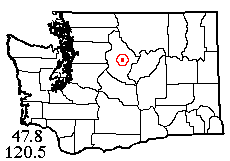 |
![]() 3 VIII 2019: Both Laurel and Markku (last time for him, before his return to Finland) were available, so for Markku's sake I tried to select a destination that might have a few butterflies: Entiat Summit Ridge north of Sugarloaf Lookout, in the same part of the state as our Mosquito Ridge trip 3 weeks earlier. I knew from a 2002 visit to the area that much of it had burned in a large forest fire around 2000. I figured a lot of habitat would have grown back by now; the 2017 aerial photos on Google Earth encouraged that thought. Oops, on arriving in the planned area (which we did with no hitches), it appeared there had been at least one, maybe two new fires since those aerial photos! Burned streaks extended through the intact forest tracts, and the area where I hoped to collect by Miners Creek was practically sterilized!
3 VIII 2019: Both Laurel and Markku (last time for him, before his return to Finland) were available, so for Markku's sake I tried to select a destination that might have a few butterflies: Entiat Summit Ridge north of Sugarloaf Lookout, in the same part of the state as our Mosquito Ridge trip 3 weeks earlier. I knew from a 2002 visit to the area that much of it had burned in a large forest fire around 2000. I figured a lot of habitat would have grown back by now; the 2017 aerial photos on Google Earth encouraged that thought. Oops, on arriving in the planned area (which we did with no hitches), it appeared there had been at least one, maybe two new fires since those aerial photos! Burned streaks extended through the intact forest tracts, and the area where I hoped to collect by Miners Creek was practically sterilized!
But here we were, so we started in a 3/4 unburned tract 200' down the west slope of the ridge. There were indeed a reasonable number of butterflies, so at least that part of the plan worked. I started sweeping thimbleberry and herbs along the dusty roadside and found it unexpectedly productive; in fact, I got far more there than in the seemingly more natural glades downslope from the road. Ultimately my sweep sample had 9 species, a great start. However, many of the young conifers had burned, so reachable tree foliage was sparse and only added 2 more species. Laurel beat Douglas-fir cones, adding a nice mature Micaria, and did very good work with dead wood on the ground, adding 4 good species and an impressive Bothropolys centipede. So far, 16 species.
At our second site there were a few more young trees to beat, and rocks instead of logs to turn over. But ultimately adding only one species, a nice Poecilochroa (Sergiolus) montana under a rock. Finally, we stopped where we could get stream access down a totally vegetation-free slope. But in the midst of this desert, the stream banks supported a lush growth of herbage that in turn had attracted ballooning spiders. Here, I sifted 2 additional species from moss and we swept at least one, probably 3 more from the lush growth. So, subject to later checking it seems we scraped together a bare-minimum 21 species! Whew!
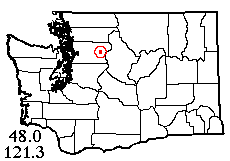 |
![]() 13 VIII 2019: Finally, a day when thunderstorms were NOT predicted for the western Cascade foothills, where I had a list of places I wanted to sample. Laurel and I picked a set of interesting sites along the North Fork Sauk River, beginning with Bedal Campground. This area looked like heaven for someone who likes to sift spiders from moss (paging Laurel!), with thick moss draping many of the trees. And picnic tables to sift on yet! She did a few loads of moss and recorded 6 spider species, not bad but not including any of her target Ozyptila. I did much worse sifting leaf litter, a measly one adult specimen (boring species too), but lots of other stuff including 4 harvestman species. Outhouses added nothing new, but a bridge just outside the camp had 5 good species, while understory (with very patchy spider populations) added 4 more. Laurel also got a spectacular female Araneus nordmanni. Total so far, 18 species.
13 VIII 2019: Finally, a day when thunderstorms were NOT predicted for the western Cascade foothills, where I had a list of places I wanted to sample. Laurel and I picked a set of interesting sites along the North Fork Sauk River, beginning with Bedal Campground. This area looked like heaven for someone who likes to sift spiders from moss (paging Laurel!), with thick moss draping many of the trees. And picnic tables to sift on yet! She did a few loads of moss and recorded 6 spider species, not bad but not including any of her target Ozyptila. I did much worse sifting leaf litter, a measly one adult specimen (boring species too), but lots of other stuff including 4 harvestman species. Outhouses added nothing new, but a bridge just outside the camp had 5 good species, while understory (with very patchy spider populations) added 4 more. Laurel also got a spectacular female Araneus nordmanni. Total so far, 18 species.
Now we headed up the river on the narrower, but not too rough, forest road 49, stopping at the trailhead for Bingley Gap and Lost Creek Ridge. Just into the woods from the trailhead is a stand of quasi-old growth with abundant dead wood to tap. I tapped for an hour or so, getting 51 specimens and what seemed like a fair diversity, but only added 5 species. Meanwhile Laurel added 3 more from roadside verge and a nice Bathyphantes keenii by the river. Conifer cones at this site were mostly closed and added no species.
Our next stop was the Harold Engles Memorial Grove, a small group of gigantic red cedar trees in the river's floodplain. Here I sifted 2 more species from cottonwood litter and Laurel managed to find 2 adult Pardosa xerampelina by the river. To conclude our day, we walked down a short trail into the gorge of North Fork Sauk Falls, an impressive cascade even now that must be awe-inspiring in the spring. But the lush gorge-side foliage added no species — or that's what I thought at the time. Curating the sample months later, I found among the many common Theridion sexpunctatum one oddball, that seems to be the elusive T. aurantium (recorded from Victoria, BC many years ago but never found in Washington until now!). Total for the area, a not-bad 31.
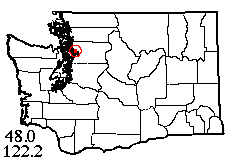 |
![]() 18 VIII 2019: This year, the Scarabs voted to hold their annual field meeting at Jetty Island in Everett city harbor, where I'd collected a little more than 2 years before. Della Scott had reserved the 11:15 ferry for us, and 9 Scarabs and parascarabs duly arrived on the sandy shore, mostly naturally vegetated except for some stands of broom and occasional blackberry. First order of business was a guided tour by a naturalist from Everett City Parks, emphasizing plants and birds. Then we separated to pursue our own interests. I wanted to see if there were any conifers on the island, and I did find a little grove of small shore pines, growing in Christmas-tree conformation with lush foliage that was easy to beat. In the course of the afternoon I got a rich pine-arachnid fauna of 2 harvestman and 12 spider species, of which all but 3 of the spiders were new records for the island. The big excitement was a male and female jumping spider that appeared to be something not seen before; 4 months later, they resumed the appearance of a familiar local species. The other Scarabs all succeeded in whatever they came for, be it bug-watching or swimming, and we all made it safely back to the mainland.
18 VIII 2019: This year, the Scarabs voted to hold their annual field meeting at Jetty Island in Everett city harbor, where I'd collected a little more than 2 years before. Della Scott had reserved the 11:15 ferry for us, and 9 Scarabs and parascarabs duly arrived on the sandy shore, mostly naturally vegetated except for some stands of broom and occasional blackberry. First order of business was a guided tour by a naturalist from Everett City Parks, emphasizing plants and birds. Then we separated to pursue our own interests. I wanted to see if there were any conifers on the island, and I did find a little grove of small shore pines, growing in Christmas-tree conformation with lush foliage that was easy to beat. In the course of the afternoon I got a rich pine-arachnid fauna of 2 harvestman and 12 spider species, of which all but 3 of the spiders were new records for the island. The big excitement was a male and female jumping spider that appeared to be something not seen before; 4 months later, they resumed the appearance of a familiar local species. The other Scarabs all succeeded in whatever they came for, be it bug-watching or swimming, and we all made it safely back to the mainland.
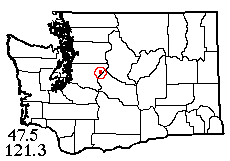 |
![]() 20 VIII 2019: This week, Jerry Austin managed to join Laurel and me for another foray into the mountains. We decided we were up for a real hike, so we headed for the Lake Dorothy trailhead, SSW of Skykomish at the edge of the Alpine Lakes. It was "only" an 800-foot elevation gain; so we climbed, and we climbed, and we climbed! Much of the trail is configured in log staircases that look very fancy but make the hiking more onerous than it need be for those with short legs! Anyway, we finally came within sight of the lake. Does the trail immediately take one to the shore? No such luck! It continues high along a steep slope above for another half mile or so, before descending within reach of what I assumed was the south end of the lake. In reality it was only halfway to the south end of this very long lake, where the north side of a peninsula looks end-ish. Anyway, the site answered well for spider collecting, even though fellow hikers and campers were there to give us an audience.
20 VIII 2019: This week, Jerry Austin managed to join Laurel and me for another foray into the mountains. We decided we were up for a real hike, so we headed for the Lake Dorothy trailhead, SSW of Skykomish at the edge of the Alpine Lakes. It was "only" an 800-foot elevation gain; so we climbed, and we climbed, and we climbed! Much of the trail is configured in log staircases that look very fancy but make the hiking more onerous than it need be for those with short legs! Anyway, we finally came within sight of the lake. Does the trail immediately take one to the shore? No such luck! It continues high along a steep slope above for another half mile or so, before descending within reach of what I assumed was the south end of the lake. In reality it was only halfway to the south end of this very long lake, where the north side of a peninsula looks end-ish. Anyway, the site answered well for spider collecting, even though fellow hikers and campers were there to give us an audience.
The wilderness lake was gorgeous, and mosquitos were fortunately long past their peak. I started beating lakeshore shrubs, getting 4 species. There were deep beds of moss on the ground just above the beach, as well as some on rocks; moss from rocks had a few spiders but those beds on the ground had seemingly none, until I found that among them were some patches of Sphagnum! Sifting this gave me plenty of specimens of what proved to be 3 species, including bog-loving Cybaeopsis wabritaskus. While I sifted, Laurel beat conifers (predominantly mountain hemlock), getting a rich fauna of 13 species, nothing extremely rare but including another adult Araneus nordmanni. Later, I discovered Jerry had been likewise beating conifers most of his time at this site, getting 6 of the species Laurel got but also 3 that she didn't. The conifer beats had no Philodromus rufus, but one of the hiker audience found one on his boot! As I prepared to leave the site, Laurel also found an adult Zygiella dispar (atypical) on a giant boulder at the foot of an adjacent talus field. This, and a couple species found along the trail as we hiked, brought us to 25 species although I didn't know at the time that we were doing that well.
Back along the trail, higher above the lake, we re-entered closed canopy forest (the trees were a bit sparse along mid-lake because of rocky terrain). Here, we stopped so I could get a dead wood sample, which worked out well with 8 species none of which duplicated the lakeshore list. Meanwhile, Jerry found a stash of the smooth cut logs used by the trail builders, and found some more Cybaeus reticulatus (also in my dead wood sample) under them. Laurel also found some under rocks! But Laurel also took time to sift some sparse moss from tree trunks and logs, getting 5 species and adding 3, including uncommon Sisis rotundus. Jerry got 8 species from another conifer beat, mostly duplicating those from the shore site, but including the day's only mature Pityohyphantes. Understory provided Laurel with nothing new, but me with some tasty huckleberries. Also at this site, Laurel tapped 100 mountain hemlock cones, getting only 5 spiders and only one of them identifiable. But we got 37 species at Lake Dorothy, including some good records, and made it down the mountain in time to reach the highway by dark.
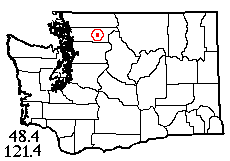 |
![]() 26 VIII 2019: On this fair, warm morning Laurel and I couldn't seem to decide which destination to head for! Finally we (or the car) picked Iron Creek, a tributary of Illabot Creek in the North Cascades, considerably farther up the long, rough Illabot road than we'd been last year. On arrival, we found the vegetation as wet as if there's just been a rain shower, so we had to start with non-net collecting techniques. The forest was so brushy here, with its floor very uneven walking, with hidden pitfalls and often steep to boot, it was quite a chore to get far from the road; so much for my plan of visiting an apparent meadow above and south of the road here. But I did manage to get down to the creek below the road, and found here some very rich (if wet) leaf litter, mixed alder leaves and hemlock needles. Sifting this got me numerous apparently mature microspiders, which kept me happily sifting more (or as happily as one can be while lying on a stony roadbed!). Turns out, the vast majority of them were common Sisicottus nesides, but the litter sample did have at least 7 species in all, including one non-obvious Walckenaeria. Laurel got enough from roadside verge to bring the sample up to 14 species.
26 VIII 2019: On this fair, warm morning Laurel and I couldn't seem to decide which destination to head for! Finally we (or the car) picked Iron Creek, a tributary of Illabot Creek in the North Cascades, considerably farther up the long, rough Illabot road than we'd been last year. On arrival, we found the vegetation as wet as if there's just been a rain shower, so we had to start with non-net collecting techniques. The forest was so brushy here, with its floor very uneven walking, with hidden pitfalls and often steep to boot, it was quite a chore to get far from the road; so much for my plan of visiting an apparent meadow above and south of the road here. But I did manage to get down to the creek below the road, and found here some very rich (if wet) leaf litter, mixed alder leaves and hemlock needles. Sifting this got me numerous apparently mature microspiders, which kept me happily sifting more (or as happily as one can be while lying on a stony roadbed!). Turns out, the vast majority of them were common Sisicottus nesides, but the litter sample did have at least 7 species in all, including one non-obvious Walckenaeria. Laurel got enough from roadside verge to bring the sample up to 14 species.
Laurel's moss-sift added 3-4 species, but her precarious balancing act over the stream netted only more Tetragnatha versicolor. Conifers in the understory added only 2, and other understory foliage, none, while I got only 2 more from some very hard-to-reach overstory conifer foliage. Laurel added one good Halorates from under rocks in a gravel bar; I had good hopes from a forest dead-wood sample, which in the end added only Cybaeus eutypus. One wolf spider, Pardosa dorsuncata, brought the site total to 24-25.
Driving out, we made a photo-op stop in a clearcut with a view, and I thought to take a GPS reading. We were still (just barely) in my sampling area, so I took 10 minutes to very quickly beat some of the young Douglas-firs and hemlocks. This added 6 more species, including a very cool male Araneus gemma, so now we can say we got 30-31 spider species (that has a much better sound!).
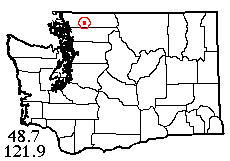 |
![]() 6 IX 2019: Ordinarily, I take a collecting hiatus from some time in August until fall, to avoid the annual dry spell when spiders are sparse. However, this year there's hardly been a week without some showers in the foothills and mountains, so as an experiment, Laurel and I tried an early September trip to another site on my western Cascades list. Not far SW of Mt. Baker, the area is reached by another one of those long dirt roads, this one passing through state forest land (road well-maintained) and into the national forest (full of potholes). We stopped at the Elbow Lake Trailhead along the Middle Fork Nooksack River. Intrepid hikers still use this trail even though a former footbridge is out and you have to ford the raging Middle Fork or cross it on a narrow, very precarious log! We were perfectly content to collect near the road without crossing the river.
6 IX 2019: Ordinarily, I take a collecting hiatus from some time in August until fall, to avoid the annual dry spell when spiders are sparse. However, this year there's hardly been a week without some showers in the foothills and mountains, so as an experiment, Laurel and I tried an early September trip to another site on my western Cascades list. Not far SW of Mt. Baker, the area is reached by another one of those long dirt roads, this one passing through state forest land (road well-maintained) and into the national forest (full of potholes). We stopped at the Elbow Lake Trailhead along the Middle Fork Nooksack River. Intrepid hikers still use this trail even though a former footbridge is out and you have to ford the raging Middle Fork or cross it on a narrow, very precarious log! We were perfectly content to collect near the road without crossing the river.
I started by sweeping grass and flowers in a small clearing around the parking lot. Hardly any spiders, and only one identifiable. Fortunately, there were a lot of young western hemlock trees fringing the clearing, so I took my spare net (the new net already has a hole in it) and thoroughly beat the conifer foliage, getting a very nice variety with 10 identifiable species, though nothing rare. Laurel and I each beat understory foliage in different parts of the forest, adding 5 species, and my brief sweep among the alders right next to the river yielded a mangled orbweaver that turned out to be introduced Metellina segmentata, the day's only non-native specimen. I added 6 species sifting alder litter (mostly from a small creek but some by the river), while Laurel's moss-sifting added 9 more including some unusual Wubana specimens that appear to be another new species! However, Laurel's best catch by far was a series of the extremely rare Cybaeopsis spenceri (including my first male of the species) taken under river cobbles in soil just inside the riparian alder. She also got a nice big Araneus nordmanni orbweaver, and some good specimens (including the day's only identifiable crab spider) from bark on a standing snag.
I ended our visit to this site with an hour's tapping dead wood pieces in the closed canopy forest, getting 6 spider species and some good harvestmen. This brought the site total to 36 species, so our September experiment was a success! We were pretty much alone during our stay at the trailhead, though a couple of carloads visited the site briefly then went away. On the way out, we stopped at the bridge over Wallace Creek (which, like the river, is glacier-fed and very milky) so Laurel could collect from the railings. This needed considerable finesse, as the bridge construction gave the spiders inaccessible hiding places! Result, no species additions, but it was still a good day!
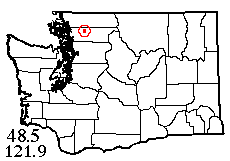 |
![]() 19 IX 2019: Continuing our September collecting experiment, on the next dry weather window we went to a site on the south bank of the Skagit River, about midway between the delta and the upper reaches. We were near a notable waterfall (Marietta Falls) but we never saw it because the trail to the falls involves fording O'Toole Creek, still very well filled with cold water! Anyway, our first stop was a river access point, unsigned but belonging to a local motorcycle club. Some grass was still dew-moist, so I began by beating understory, successfully (12 species). Laurel, as usual, sifted moss, which was abundant on the maples, and likewise got 12 species. Maple leaf litter, though rather wet, was abundant, and I sifted one large and 2 small bags full — for another 12 species! Allowing for overlap, these first 3 habitats got us 26 species. Laurel's collecting along the river bank added 2 more.
19 IX 2019: Continuing our September collecting experiment, on the next dry weather window we went to a site on the south bank of the Skagit River, about midway between the delta and the upper reaches. We were near a notable waterfall (Marietta Falls) but we never saw it because the trail to the falls involves fording O'Toole Creek, still very well filled with cold water! Anyway, our first stop was a river access point, unsigned but belonging to a local motorcycle club. Some grass was still dew-moist, so I began by beating understory, successfully (12 species). Laurel, as usual, sifted moss, which was abundant on the maples, and likewise got 12 species. Maple leaf litter, though rather wet, was abundant, and I sifted one large and 2 small bags full — for another 12 species! Allowing for overlap, these first 3 habitats got us 26 species. Laurel's collecting along the river bank added 2 more.
Next, with the day increasingly pleasant and warm, we headed west to the bridge over O'Toole Creek; Laurel was delighted with the bridge, getting 9 species from the railings. These included recently introduced Ero tuberculata, though we'd found native E. canionis in 2 habitats at the first site. A gated dirt road across the highway from us (in the direction of the river) led to a gigantic grass field (property of the city of Seattle), by this time nice and dry, though the sun never really fully emerged from the mostly cloudy sky. We both swept, sampling only a tiny percentage of the whole field, getting 11 species with almost no overlap with other habitats. I also caught one solitary Pardosa moesta with an egg sac. I ended the sample by beating young conifers at the field edge (nicely varied, including spruce, Douglas-fir, true fir, hemlock and cedar!), which only added a few species. But overall, the great habitats at these sites got us a splendid 45 species. September is a success!
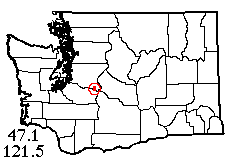 |
![]() 25 IX 2019: Our last September outing fulfilled a plan of long standing, to cross the Greenwater River (by a previously visited bridge some 20 miles ESE of Enumclaw) and see how close we could come to the summit ridge of Huckleberry Mountain by a maze of old and new logging roads. On reaching a certain point, we tried a turn on a road the car couldn't negotiate. After some collecting at the stopping-point, we tried hiking up said road only to find that it soon stopped — wrong turn! But worthwhile, since the road's end produced a mature Tarentula kochii and some tappable Douglas-fir cones containing an unexpected Poecilochroa columbiana. Back at the car, we drove on to find the real right turn, and amazingly managed to continue all the way to the 4600-foot crest of the mountain! A beautiful parkland-like habitat greeted us (partly the result of timber harvest, but with some natural meadows). Here I got a moderately good sweep sample, plenty from conifers but little that was new, and a little good litter from an alder thicket. I kept finding lots and lots of Dictyna, expecting to find one or two good species represented, but every last one was juvenile! Laurel, who'd gone the other direction on the ridge crest, got some mature Phidippus johnsonii and a couple of other goodies. At this point we had 24 species.
25 IX 2019: Our last September outing fulfilled a plan of long standing, to cross the Greenwater River (by a previously visited bridge some 20 miles ESE of Enumclaw) and see how close we could come to the summit ridge of Huckleberry Mountain by a maze of old and new logging roads. On reaching a certain point, we tried a turn on a road the car couldn't negotiate. After some collecting at the stopping-point, we tried hiking up said road only to find that it soon stopped — wrong turn! But worthwhile, since the road's end produced a mature Tarentula kochii and some tappable Douglas-fir cones containing an unexpected Poecilochroa columbiana. Back at the car, we drove on to find the real right turn, and amazingly managed to continue all the way to the 4600-foot crest of the mountain! A beautiful parkland-like habitat greeted us (partly the result of timber harvest, but with some natural meadows). Here I got a moderately good sweep sample, plenty from conifers but little that was new, and a little good litter from an alder thicket. I kept finding lots and lots of Dictyna, expecting to find one or two good species represented, but every last one was juvenile! Laurel, who'd gone the other direction on the ridge crest, got some mature Phidippus johnsonii and a couple of other goodies. At this point we had 24 species.
Reluctantly leaving the splendid views from the ridge (south to cloud-capped Mt. Rainier and north to endless foothills in the Green River Watershed), we wound back down the road to a nice mature forest stand where I hoped to collect from dead wood. There was enough of it there, but spiders were rather sparse in that habitat, adding 4 species however. Laurel added 4 more from conifer foliage including a nice male Araneus nordmanni, and also found a couple of Pardosa with egg sacs; now up to 33 species. With the sun close to setting, we made one last stop at a small creek in a mossy ravine, 2800' in elevation, where Laurel sifted moss on the car's trunk while I sifted alder litter on the hood. Each of our sifts made 5 different additions to the total, for 43 species! Didn't find any Ozyptila for Laurel's project, but other than that we can't complain!
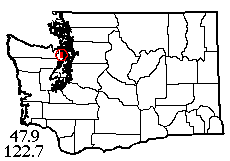 |
![]() 10 X 2019: Today for a change we took the Kingston ferry, then crossed the Hood Canal Bridge and went up the Chimacum Valley to Egg and I Road, where the events of one of my favorite books took place nearly a century ago. Some of the descendants of the colorful characters of The Egg and I still live in the area. Our goal was a half square mile of public timberland right next door to Egg and I Farm. I had hoped to reach a nice maple forest around a spring to the north of one of the logging roads, but off-road going was made unnecessarily difficult by logs, branches, and especially the double-damned Himalayan blackberries! However, we found a nice sunny spot in the clearcut where Laurel could sweep abundant dew-free grass and I had more young conifer foliage than I could have beaten in a week. These 2 habitats alone got us 18 species, only one being somewhat rare, Linyphantes eureka from the sweep sample.
10 X 2019: Today for a change we took the Kingston ferry, then crossed the Hood Canal Bridge and went up the Chimacum Valley to Egg and I Road, where the events of one of my favorite books took place nearly a century ago. Some of the descendants of the colorful characters of The Egg and I still live in the area. Our goal was a half square mile of public timberland right next door to Egg and I Farm. I had hoped to reach a nice maple forest around a spring to the north of one of the logging roads, but off-road going was made unnecessarily difficult by logs, branches, and especially the double-damned Himalayan blackberries! However, we found a nice sunny spot in the clearcut where Laurel could sweep abundant dew-free grass and I had more young conifer foliage than I could have beaten in a week. These 2 habitats alone got us 18 species, only one being somewhat rare, Linyphantes eureka from the sweep sample.
But on a fall trip it's really necessary to do sifting! Laurel identified a seeming game trail that took us down to the ravine with only moderate struggling, but there was too much blackberry to penetrate more than a few feet into the deciduous stands. Fortunately, litter obtained (with scratched hands) from under the first significant maple tree yielded 8 species, one bag of alder litter added Nesticus silvestrii, and sparse moss added 5 (plus one big Cybaeus on the ground), bringing us up to 33. Struggling back up out of that ravine was an epic effort! Back at the road, a little shack at the farm entry gave me one house spider. Up to this time, with warm sunlight and pleasant walking (but only on the roads!) we hadn't seen another person.
There being considerable daylight left, Laurel wanted to try for some pine cones in Chimacum town to the north. The score: cones 50, spiders 2. On our way south through the gridspace, we stopped in a couple of spots where we hoped there would be more to sift, and finally found one on Swansonville Road where there was real moss draping some of the riparian trees. By this time it was getting too cold to sift litter. But the moss added 4 species and fern understory added 5, making 43 for the day; 46 with the 3 prior records.
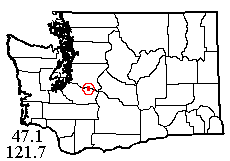 |
![]() 15 X 2019: For our second October trip, we wanted to collect along the White River a few miles SE of Enumclaw, at the upper end of Mud Mountain Reservoir on Corps of Engineers land. But we found the access road blocked off by an excavating crew and their dirt piles. So, plan B was a private tract of timberland in the next area to the east. That was reached without trouble and contained a lovely and very interesting forest tract and two clearcuts, dating from about the end of 2014, that already had some well-grown Christmas-sized trees — and plenty of blackberry! Our first subsite was a forest tract with cottonwood, maple, alder, a few conifers and plenty of vine maple, fern and salmonberry. Here, Laurel got a most successful sift sample from tree trunk moss, with 16 spider species. I got 7 others from understory, and a relatively poor leaf litter sift added three; however, one of those was the rarely-seen male of our remarkable, primitive coastal forest spider Hexura picea. Later on, my beating roadside hemlocks added 2 more for this site, making 26 already!
15 X 2019: For our second October trip, we wanted to collect along the White River a few miles SE of Enumclaw, at the upper end of Mud Mountain Reservoir on Corps of Engineers land. But we found the access road blocked off by an excavating crew and their dirt piles. So, plan B was a private tract of timberland in the next area to the east. That was reached without trouble and contained a lovely and very interesting forest tract and two clearcuts, dating from about the end of 2014, that already had some well-grown Christmas-sized trees — and plenty of blackberry! Our first subsite was a forest tract with cottonwood, maple, alder, a few conifers and plenty of vine maple, fern and salmonberry. Here, Laurel got a most successful sift sample from tree trunk moss, with 16 spider species. I got 7 others from understory, and a relatively poor leaf litter sift added three; however, one of those was the rarely-seen male of our remarkable, primitive coastal forest spider Hexura picea. Later on, my beating roadside hemlocks added 2 more for this site, making 26 already!
Now we split up to sample clearcut habitats; I took the west one, Laurel the east. I added 10 species from sweeping and young trees at my end, and I was expecting Laurel's sweep sample at the other clearcut to be all duplication, but no such thing! It actually added 5 more species including very interesting records of Misumenops lepidus and Neoscona arabesca. Also, she found introduced Metellina segmentata in her clearcut whereas the many Metellina I found in the forest were all native M.curtisi. Who knew adjacent places could have such differences?
In the east part of the forest tract, a vigorous stream (Clay Creek) in a deep ravine passes far under the highway (in a culvert), where guardrails produced 5 species for Laurel including a male ant-mimic Micaria. Just east of the stream, the forest becomes mature closed-canopy conifers on a series of little hills (possibly an ancient landslide), where I spent some time trying for dead-wood spiders; not very productive, only 3 species. Laurel tried this route to reach the river but didn't quite make it; she came back with a bag of moss that added one more species, Clubiona pacifica. Total, 44 from what we might call a desperation site. There's nothing like collecting in the fall! We had a nice warm day for it too, just before the rains resumed.
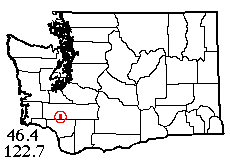 |
![]() 24 X 2019: On an ideal Indian-summer day (warm, dry and sunny), Laurel and I went far south to a site east of Toledo (Washington, not Ohio!) on the Cowlitz River. I hoped to find a grassland remnant of erstwhile Cowlitz Prairie. Peripheral to a trout hatchery are several tracts belonging, for some reason, to the city of Tacoma. On one of them is Blue Creek Boat Launch with its well-known wheelchair fishing facility. We began collecting in the fringe of cottonwood along the river. Air smelled smoky, likely someone burning leaves on the far side. I sifted 7 species from thin leaf litter and Laurel got 14 from moss on the trees. Adding a few outhouse spiders, we already had 21 species! At the far end of the parking lot was a broader expanse of riparian forest containing maples and conifers, and I decided to try that for better litter. I found some too, sifting 9 spider species and some cool harvestmen from it. Laurel eventually followed me to my site (a log that made a nice sifting platform) and did another moss sample there while I beat the understory, somewhat frustrating because it kept filling my net with tree leaves. Here, among a few other additional species, Laurel found adults of crab spider Ozyptila pacifica, which is exactly what she wanted for her project. Adding the understory, we now had 40 species, with major habitats still to go!
24 X 2019: On an ideal Indian-summer day (warm, dry and sunny), Laurel and I went far south to a site east of Toledo (Washington, not Ohio!) on the Cowlitz River. I hoped to find a grassland remnant of erstwhile Cowlitz Prairie. Peripheral to a trout hatchery are several tracts belonging, for some reason, to the city of Tacoma. On one of them is Blue Creek Boat Launch with its well-known wheelchair fishing facility. We began collecting in the fringe of cottonwood along the river. Air smelled smoky, likely someone burning leaves on the far side. I sifted 7 species from thin leaf litter and Laurel got 14 from moss on the trees. Adding a few outhouse spiders, we already had 21 species! At the far end of the parking lot was a broader expanse of riparian forest containing maples and conifers, and I decided to try that for better litter. I found some too, sifting 9 spider species and some cool harvestmen from it. Laurel eventually followed me to my site (a log that made a nice sifting platform) and did another moss sample there while I beat the understory, somewhat frustrating because it kept filling my net with tree leaves. Here, among a few other additional species, Laurel found adults of crab spider Ozyptila pacifica, which is exactly what she wanted for her project. Adding the understory, we now had 40 species, with major habitats still to go!
Back near the hatchery turnoff is a big semi-marshy meadow, bordered by Blue Creek and its tributary Alexander Creek. I set out to sweep the meadow. Naturally I tried some of the tallest grass but without warning found myself over the shoe-tops in a marsh! Good thing it was a warm day... My sweep sample eventually added 10 more species, including one of the increasingly rare native orbweavers, Araneus trifolium. Meanwhile Laurel swept in an adjacent marsh along Alexander Creek, getting 4 species that were different, the coolest being a juvenile Dolomedes and several adult Pachygnatha (tetragnathid orbweaver that makes no web). Both of us also beat meadow-edge conifers, making several more additions including one female (no doubt a ballooner) of the bog spider Hybauchenidium cymbadentatum.
There was one more adjacent place I wanted to try, a forest tract north of the road that leads to a huge open-water marsh. It's a lovely spot (especially with fall colors) but someone was shooting not far ahead of me and it was quickly getting dark, so I contented myself with beating some salal bushes. Counting all the species later, I was amazed to find we got 62+ spider species for the day! And serendipity wasn't over yet. Distracted by taking sunset pictures, I missed a turn on the road out and we found ourselves in the town of Toledo, having to turn around to get back to I-5. We had to eat anyway, so I suggested we stop at a tiny but somehow inviting-looking burger-diner called Betty's Place. Those deluxe burgers were utterly delicious! I'd recommend Betty's to anyone traveling through Lewis County.
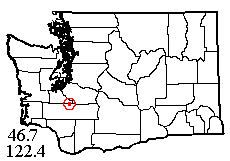 |
![]() 1 XI 2019: After a week of dry but too-cold weather, temperatures were set to moderate somewhat. Getting site-specific forecasts from the NOAA website, I found that the warmest was for a planned field site on the upper Deschutes River, far eastern Thurston County. To get to the river, we'd have to traverse a 10+-year-old clearcut, which might be quite a struggle (Laurel sharpened up her machete in case of blackberry)! But the high-resolution Google Earth photos showed what appeared to be slender pathways through the clearcut to an old road, then through the overgrown riparian woods down to the river. And those photos told no lie — we duly found the paths just where they appeared to be, and followed a trouble-free route to the north bank of the Deschutes, a small river at this point but widened by a recent beaver pond.
1 XI 2019: After a week of dry but too-cold weather, temperatures were set to moderate somewhat. Getting site-specific forecasts from the NOAA website, I found that the warmest was for a planned field site on the upper Deschutes River, far eastern Thurston County. To get to the river, we'd have to traverse a 10+-year-old clearcut, which might be quite a struggle (Laurel sharpened up her machete in case of blackberry)! But the high-resolution Google Earth photos showed what appeared to be slender pathways through the clearcut to an old road, then through the overgrown riparian woods down to the river. And those photos told no lie — we duly found the paths just where they appeared to be, and followed a trouble-free route to the north bank of the Deschutes, a small river at this point but widened by a recent beaver pond.
Several beatable firs nearby yielded 8 spider species to my net. Laurel's sweeping along the shore added 3. Then it was time for sifting, which produced a seeming unfair disparity of results! Air temperature seemed to be over 50 so I expected good results from leaf litter, but the litter was apparently still too cold, giving me but a single spider species, Usofila pacifica (3 specimens), ultimately supplemented by a solitary Coreorgonal. Meanwhile, Laurel was getting a record-breaking set of 20-21 species from moss on assorted river-bottom trees. Included were 2 Clubiona species, a nice Meriola, and 3 adults of one of the Ozyptila crab spiders she's studying, showing some odd genitalic variation. I did some field sweeping inland from the river and added 3 more, including the rare, bizarre Tmarus angulatus. Our sample was 33 species at this point.
Next we hiked back up our mysterious trail to the clearcut. There, Laurel swept grass and I beat some of the young replanted Douglas-fir, between us boosting the collection to 40 species. Back at the car, forest understory and fallen cones added 2 more each. For our final site, we navigated a long way around to a nearby rural housing development that featured a bridge across the river, less than a mile upstream from where we'd just been. It turned out this bridge was in what almost amounts to a gated community, but all the natives were friendly. Laurel's expectation of good stuff from the bridge railings was disappointed here, but I first got an Araneus diadematus from the ivy draping bridge-side trees, then gathered a bag of litter (from the one spot not posted no-trespassing) to warm up and sift at home. That worked out very well, adding 4 more spider species including the seemingly new Ozyptila species I'd found in Lewis County in March 2018 — even though this litter was about half ivy leaves! In all, a fine trip featuring several strokes of luck! Total catch, 49 species.
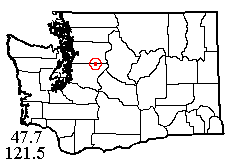 |
![]() 6 XI 2019: The unseasonable dry spell kept getting extended until we had another opportunity to collect. Most destinations had predicted highs of no more than 53, but what the heck, I could always take a bag of leaf litter home. So we went to the area of Eagle Falls/Halford along the South Fork Skykomish River. On arrival, temperatures were chilly but didn't feel really cold, and there was pleasant sunlight falling on the highway. The downside of sifting on our parked car was that every time a truck passed, the tailwind played hob with the sifted specimens. However, Laurel managed to sift 15 spider species (nothing especially rare) from moss on the rainforest-like trees along the river. As is often the case, leaf litter (even with sun on it) seemed to be colder than the moss, and I only added 3-4 species from my litter sift. However, that included a range extension for introduced Zodarion rubidum plus the trip's one specimen of Ozyptila (Laurel's research project), a female O. pacifica, so well worth while. A crew was doing maintenance on the parallel railroad tracks with a device called the "Dynamic Tamping Express"!
6 XI 2019: The unseasonable dry spell kept getting extended until we had another opportunity to collect. Most destinations had predicted highs of no more than 53, but what the heck, I could always take a bag of leaf litter home. So we went to the area of Eagle Falls/Halford along the South Fork Skykomish River. On arrival, temperatures were chilly but didn't feel really cold, and there was pleasant sunlight falling on the highway. The downside of sifting on our parked car was that every time a truck passed, the tailwind played hob with the sifted specimens. However, Laurel managed to sift 15 spider species (nothing especially rare) from moss on the rainforest-like trees along the river. As is often the case, leaf litter (even with sun on it) seemed to be colder than the moss, and I only added 3-4 species from my litter sift. However, that included a range extension for introduced Zodarion rubidum plus the trip's one specimen of Ozyptila (Laurel's research project), a female O. pacifica, so well worth while. A crew was doing maintenance on the parallel railroad tracks with a device called the "Dynamic Tamping Express"!
Next, onward to a Forest Service road (#6022) that crosses the tracks and heads uphill a little farther upriver. I swept grass along the railroad tracks (2 different times) and got exactly one spider, a Tibellus (one more species!). Up the road in the forest (past an unexpected stream ford), I decided to ascend into the warming afternoon sun and beat ferns. Ten species, quite a nice beat sample! Laurel did less well on shade ferns and shade moss, adding nothing new. Back in the shade myself, I tried sifting forest maple litter. It didn't feel especially cold, but produced only 3 species. A similar bag, brought home and warmed to room temperature, added 4 more species as well as other good stuff, such as a nice series of Oskoron harvestmen. Finally, we hiked down the track to where I could beat cedar foliage — adding one more. A spruce tree back by the car added nothing. Total, 34 species which isn't bad at all considering the conditions! Moreover, we arrived at Zeke's in plenty of time to get very filling burgers.
The final 2019 field trip is finally posted! Still hoping to get out more in 2020 despite the pandemic.
This page last updated 21 March, 2025